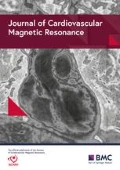Introduction
Recently, self-navigation has become an alternative to breath-holding and respiratory navigators for cardiac MR scans [1–3]. Current sequences acquire a high spatial-resolution navigator projection every cardiac phase [i.e. [4]], a lower resolution navigator every TR, or a complete image with lower temporal resolution [2]. Temporal or spatial resolution is sacrificed to minimize the loss of imaging efficiency. Here, we propose a dual-echo balanced SSFP-based imaging sequence that acquires a constant navigator projection during every TR and alternates navigator projection direction for robust motion measurement.
Purpose
To develop a self-gating cine sequence for high-resolution imaging studies.
Methods
Figure 1 displays the pulse sequence and k-space trajectories for the proposed sequence. Two complete readouts are acquired with an interposed navigator echo per TR. Navigator orientation, given by angle θ relative to readout, is independent of the readout direction. To minimize TR, an efficient gradient waveform design technique was applied. The images from each imaging echo were reconstructed separately and combined using root-sum-squares. MRI: One normal human subject was scanned on a 1.5 T Espree (Siemens Medical Systems) with using a 32-channel cardiac array. Imaging was approved by the local IRB and informed consent was given. Short-axis images were acquired during free breathing over a period of ∼ 200 s. Typical parameters: α = 35°, TR/TE1/TE2 = 5.1/1.5/3.7 ms at 977 Hz/pixel, 6 mm slices, 256 × 256 matrix, 34 cm FOV, 128 point nav with a 25.6 cm nav FOV. A breath-held single-echo bSSFP sequence (TR/TE 3.4/1.7 ms, ∼ 20 s duration was acquired for comparison. Respiratory self-navigated images were generated offline and respiratory cycles were manually identified.

Figure 2
Results
Figure 2a displays the navigator projection traces acquired with interleaved TRs. Each navigator trace contains approximately ∼ 4,000 projections. Note the visualization of cardiac and respiratory motion in the traces and the irregular breathing pattern of the volunteer.

Figure 2
Conclusion
We present a pulse sequence specifically designed for high-resolution imaging, with two different but constant nav projections acquired in alternating TRs. The navigator direction was used to minimize TR. Neither image nor navigator orientation was chosen to align with the lung-liver interface: having dual navigators should increase the chance of capturing relevant motion patterns. The processing steps necessary to fully and automatically utilize such high spatial/temporal resolution projections remains to be explored. This technique has application in patient scans where breath-holds are not possible, or where the desired resolutions make breath-holds untenable.
References
Larson et al: MRM. 2004, 51:
Larson et al: MRM. 2005, 53:
Larson et al: MRM. 2001, 46:
Lai et al: MRM. 2008, 59:
Author information
Authors and Affiliations
Rights and permissions
Open Access This article is published under license to BioMed Central Ltd. This is an Open Access article is distributed under the terms of the Creative Commons Attribution 2.0 International License (https://creativecommons.org/licenses/by/2.0), which permits unrestricted use, distribution, and reproduction in any medium, provided the original work is properly cited.
About this article
Cite this article
Herzka, D.A., Guo, L., McVeigh, E.R. et al. An interleaved-navigator projection dual-echo bSSFP sequence for respiratory self-gated imaging. J Cardiovasc Magn Reson 12 (Suppl 1), P84 (2010). https://doi.org/10.1186/1532-429X-12-S1-P84
Published:
DOI: https://doi.org/10.1186/1532-429X-12-S1-P84

